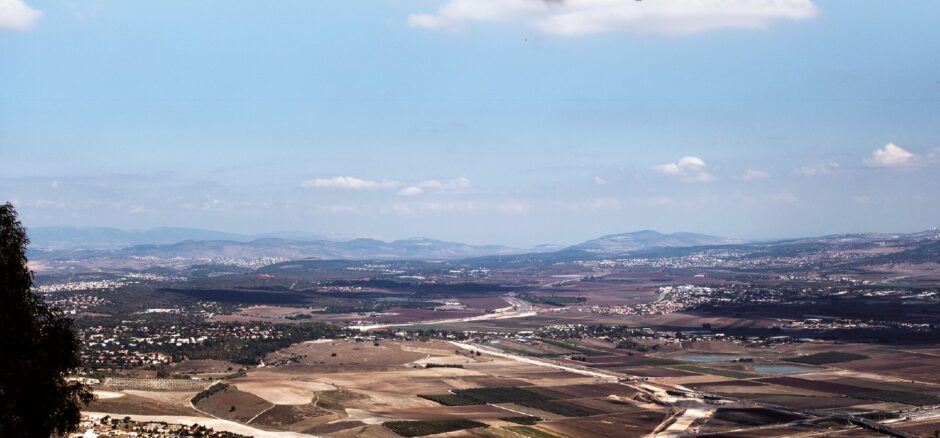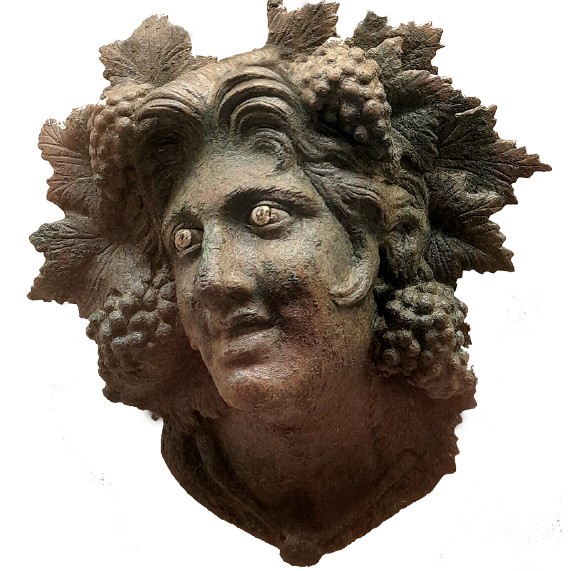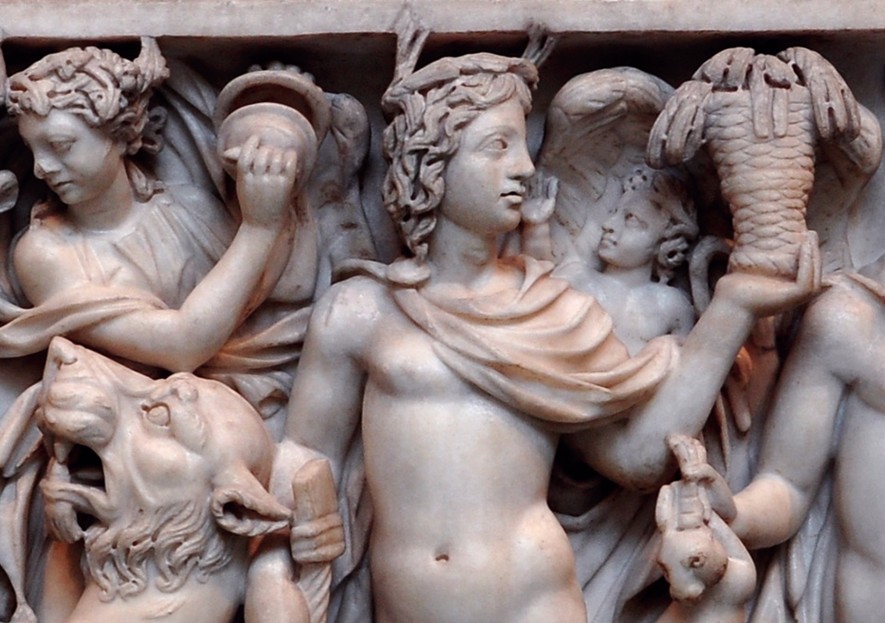Opponents of Christianity present many and varied arguments to sow doubt in believers’ minds. This is one of them. The argument goes like this:
1. Dionysus was a god in Greek mythology, who was worshipped long before Jesus Christ lived.
2. There are many similarities between Dionysus and Jesus Christ. He was the son of God and a human mother; he was rejected by his people; he miraculously produced wine; he allowed himself to be captured, and his story involves death on a tree; he died and rose to life again; he was able to bestow the blessing of special life on his followers; his followers demonstrated their allegiance by holding ceremonies in which they symbolically ate his flesh; his followers were spiritually married to him.
3. Dionysus was widely worshipped in the Middle East in the First Century ad—the time and place of Jesus and the birth of Christianity.
4. Therefore, Christianity is not original and not true, it’s merely a Jewish adaptation of the Greek Dionysus cult.
On the face of it, it’s a devastatingly powerful argument. It’s caused some Christians to abandon their faith. But like all such arguments, it falls down when you examine it.
Which Came First?
There certainly are similarities between themes found in classical mythology and the Bible. In some cases, this is simply coincidence—for example all religions deal with big universal issues, such as life after death. But there are also instances where a similarity is so specific that it seems that one religion may have adopted a story from another: for example, the main character being the son of God and a mortal woman. When similarities like this occur, critics usually assert that the Bible has borrowed from contemporary mythology. But they must also accept that it could be the other way round.
We know that the ancient world of the Middle East was a melting pot of cultures and ideas. For example some Greek myths are very similar to Egyptian and Indian myths. We also know that Jewish culture and religion was well known in the contemporary ancient world. The Bible’s Old Testament recounts many instances of Israelites interacting with neighbouring civilizations. For example the nation of Israel lived in Egypt until around 1500 bc. When they occupied the land of Canaan under their judges and kings they fought with and befriended the surrounding nations including the Cretans (Philistines) (Judges 13), Tyrians (1 Kings 5), Arabians (1 Kings 10), Assyrians (2 Kings 18), Babylonians (Daniel 1), and Persians (Ezra 1). Later, the land of Israel was part of the Greek empire from the 4th to the 2nd Centuries bc.
Comparing Christ and Dionysus
Dionysus first appears in the archaeological record as early as the 13th Century bc, but little is known about him at that stage. It’s not until the classical period, around the 8th Century bc, that his stories emerge in Greek poetry, plays and artwork. He’s perhaps best known as the god of wine—he invented it, and gifted it to mortals to bring them joy. He’s also the god of ecstatic madness (linked to his role as the god of wine), and a god of nature.
We’ll look at the various details of the Dionysus myth, and compare them to the equivalent details in the Christian story. I think we’ll notice three things in particular:
1. Many of the similarities are so vague that they’re evidently just coincidence.
2. Where there is a plausible comparison it’s likely that it was actually the Greeks who borrowed the detail from the Bible. We’ll see that the details of Christ’s life which are alleged to be copied from the Dionysus myth were actually foretold beforehand in the Bible’s Old Testament, for example in Genesis (probably compiled by Moses around 1500 bc), in the time of King David (1000 bc) and the Hebrew prophets, notably Isaiah (600 bc).
3. There are a couple of instances where it appears that Jesus deliberately referenced the Dionysus myth in his teaching.
Son of God and a Mortal Woman
The Greek story: The chief god Zeus seduced a princess called Semele and made her pregnant. Zeus’s jealous wife Hera tricked him into killing Semele, but as she died he rescued her unborn child and sewed him into a gash in his thigh, from where the baby was born in due course. (Dionysus is actually one of at least six Greek gods who had human mothers.)
The Bible story: The Gospel records narrate the circumstances of Jesus Christ’s birth in careful detail. The angel Gabriel appeared to the virgin Mary and told her she was to bear the Son of God, who would save his people from their sins and be the ruler of Israel (Luke 1:26–38). This was the fulfilment and culmination of many Old Testament prophecies (for example Isaiah 7:14). From the beginning, the Bible presents a developing picture of the Son of God who was to come into the world to bring salvation to humankind: descendant of the woman (Genesis 3:15), descendant of Abraham (Genesis 12:7), and son of God (2 Samuel 7:12-15).
Rejection, Arrest and Death
The Greek story: During his travels Dionysus was captured by pirates. He turned himself into a lion and chased them overboard, and they were turned into dolphins. He was also insulted by King Lycurgus, whom Zeus killed in revenge. Later, he allowed himself to be captured by King Pentheus, in order that he could try to persuade Pentheus to worship him. When Pentheus refused to listen, Dionysus tricked him into climbing a tree, then drove a group of women into a mad rage so that they attacked Pentheus and tore him to pieces.
The Bible story: The Gospels vividly describe the deepening antagonism of the Jewish religious rulers towards Jesus, for example Matthew 12:14. They describe the rulers’ deepening fear and hatred of him, until at last they had him arrested and executed. His rejection was foretold in the Old Testament. For example, the life of Joseph is a detailed allegory of the life of Christ—he was rejected by his brothers but in the end was their saviour (Genesis 45:5). Isaiah 53 is a detailed and deeply moving prophecy of the suffering saviour, who was ‘despised and rejected by men…with his wounds we are healed’ (vs. 3–5).
He laid down his life and refused to avenge himself, in fact one of his final pleas to God was, ‘Father, forgive them, for they know not what they do’ (Luke 23:34).
Resurrection
The Greek story: The infant Dionysus was torn apart by the Titans at the behest of Hera. However, his heart was saved by the goddess Athena, and he was reborn.
The Bible story: The death and resurrection of Jesus Christ are described in detail in the four Gospel records. The reality of his resurrection is at the very heart of the Gospel (for example 1 Corinthians 15).
Blessing of Special Life
The Greek story: As the god of wine, Dionysus offered his worshippers a state of ecstasy and liberation from constraint. During frenzied and sometimes violent cultic celebrations his followers claimed to undergo a spiritual transformation. Also, as the god of vegetation and fertility, he brought blessings of health and abundance to his devotees.
The Bible story: Jesus Christ claimed to be no less than ‘the way, the truth, and the life’ (John 14:6). He is the Son of God who laid down his life to give us life (1 John 3:16). To follow Christ is to enjoy the blessing of being a child of God, with all the joy that brings (Ephesians 1:3), and also to have confidence in eternal life to come (1 John 3:2).
Eating His Flesh
The Greek story: Dionysus had female devotees known as Maeneads, who engaged in mad ecstatic rituals which often involved eating raw flesh—sometimes dismembering live animals. They saw this as an act of communion with Dionysus, the god of nature.
The Bible story: Jesus shocked his audience in the synagogue in Capernaum when he said, ‘Whoever feeds on my flesh and drinks my blood has eternal life, and I will raise him up on the last day’ (John 6:54). As Capernaum was in a Gentile region where the Dionysus cult was prominent, it’s likely that the audience was uncomfortably reminded of the customs of Dionysus worship. Jesus may even have been making a deliberate reference to it, in order to make an impression on them.
But far from the vile excesses of the Dionysiac rites, Jesus was explaining that he wants us to feed upon him spiritually. He explained that he is the true ‘bread of life’, in fulfilment of the manna which God provided to feed Israel in the wilderness (John 6:48–51). He is also the fulfilment of the Passover lamb, which the Israelites killed and ate on the night they were freed from their slavery in Egypt (1 Corinthians 5:7–8). To feed on Christ is to internalise him: ‘If Christ is in you, although the body is dead because of sin, the Spirit is life because of righteousness’ (Romans 8:10). At the Last Supper on the night before he died, Jesus progressed this thought when he commanded his disciples to share bread and wine in fellowship with him (1 Corinthians 11:23–26).
The Spiritual Bride
The Greek story: Dionysus was married to the human princess Ariadne. He had numerous children, by her and other women. It’s thought that the frenzied dancing of the Dionysian rituals was a way of symbolically joining in union with him.
The Bible story: Jesus was celibate. He told parables in which he is the bridegroom and his followers are the bride (for example Matthew 9:15). This theme is explored more deeply in the writing of the apostles (Ephesians 5:25–27), and in the sublime description in Revelation 19:7 of his return to establish God’s Kingdom: ‘Let us rejoice and exult and give him the glory, for the marriage of the Lamb has come, and his Bride has made herself ready.’
Miraculous Production of Wine
The Greek story: At the annual Dionysia festivals which were held around the Greek world each year, three empty jars were said to miraculously fill with wine. The wine had to be drunk in the temple, because it would turn to water if it was taken outside.
The Bible story: The first miracle of Christ which is recorded in John’s gospel is in chapter 2, when Jesus turned the contents of six water pots into wine. Much is made of this by the theorists, because it’s seen as the most persuasive argument that the Christian Gospel borrowed from the Dionysus cult. There is no Old Testament precedent for miraculously producing wine, whereas the tradition of the Dionysian wine jars dates back to several centuries bc. Archaeological evidence shows that the Dionysus cult was widespread in Galilee, which was the region where Jesus performed the miracle (John 2:1–11).
Why did Jesus perform this miracle? Various reasons have been identified. First, there was a need for help and he was able to provide it. Second, it was an indication that he was sharing in the work of God of which the prophet spoke: ‘Come, everyone who thirsts, come to the waters; and he who has no money, come, buy and eat! Come, buy wine and milk without money and without price’ (Isaiah 55:1).
Third, the miracle was no doubt prophetic itself. Jesus was looking forward to his own marriage, at his return to take his bride and establish God’s Kingdom (as we noted in the previous section) (Mark 14:25).
And fourth, very probably, by filling six water pots with wine Jesus was signalling his superiority to Dionysus, the god who was widely worshipped in the region and was celebrated for filling three pots.
False and True Religion
It seems to me that there’s actually very little similarity between Dionysus and Jesus Christ. Those similarities we do notice can be identified either as coincidence, or as the Greeks borrowing from the Hebrew Bible, or even as Christ himself deliberately referencing the Dyonisian cult.
Dionysus was the god you’d expect from human imagination—capricious, vengeful, cunning and promiscuous. On the other hand, the Gospels paint a detailed picture of the character, words and actions of Jesus Christ as the perfect man who provides for us an example of everything we should aspire to be. And in addition, our Saviour:
These are written so that you may believe that Jesus is the Christ, the Son of God, and that by believing you may have life in his name (John 20:31).
The Dionysian cult focused on indulgence and self-gratification (which was no doubt why it was so popular), and alcohol abuse as a route to spiritual transformation. Christianity is a way of life which involves recognising and resisting what is ungodly in us (Luke 9:23), and striving to be like God (1 Peter 1:16), with a view to eternal life in the Kingdom which is to come (Matthew 6:33).
It’s immensely sad when an unstable faith is capsized by clever arguments for which it’s not prepared. Attacks on our faith are nothing new. The Apostle Paul urged his brothers and sisters:
Let your manner of life be worthy of the gospel of Christ, so that whether I come and see you or am absent, I may hear of you that you are standing firm in one spirit, with one mind striving side by side for the faith of the gospel, and not frightened in anything by your opponents. This is a clear sign to them of their destruction, but of your salvation, and that from God (Philippians 1:27–28).

Doug Potts


